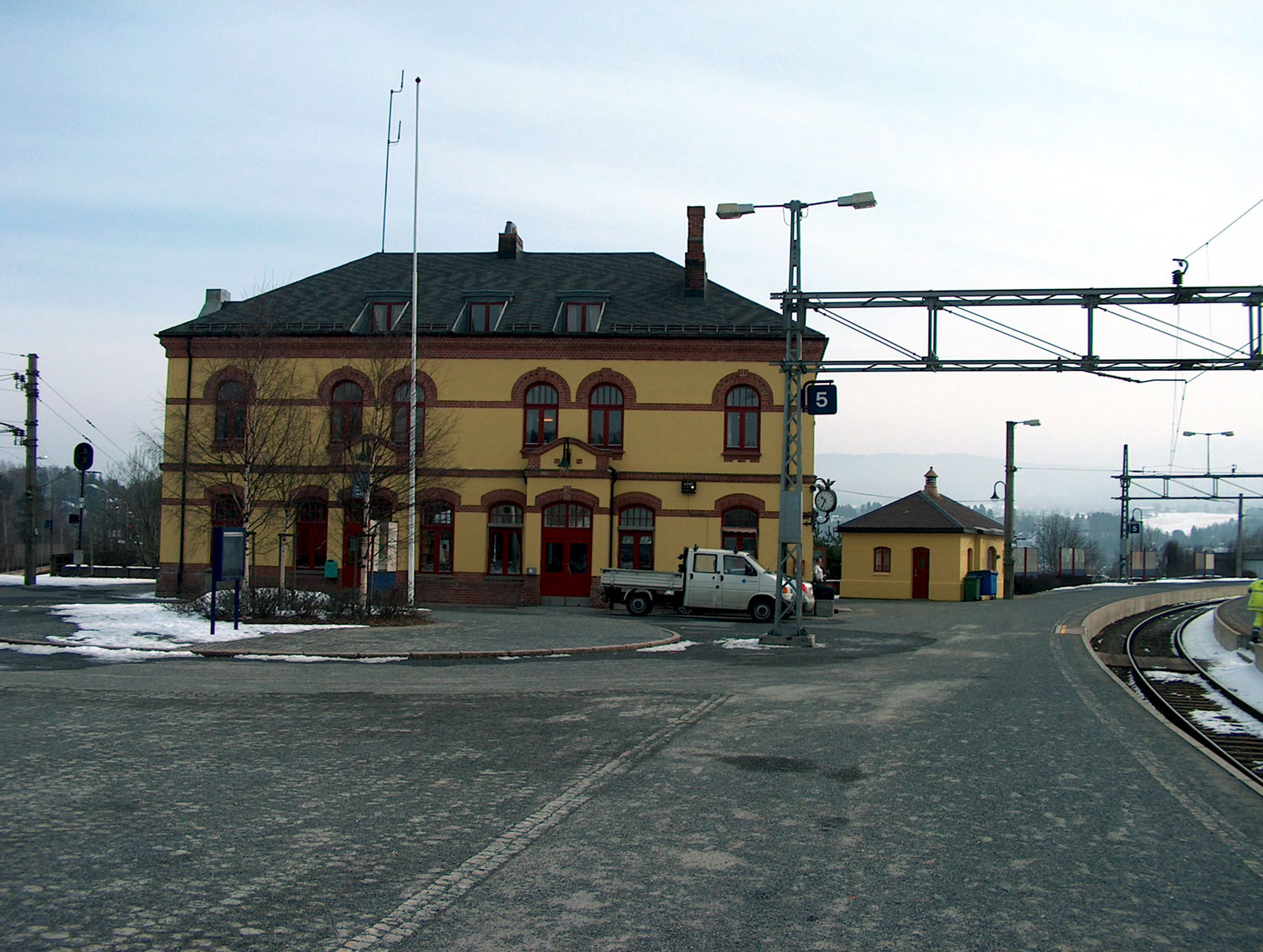- Hønefoss Station
Infobox Norwegian station
name = Hønefoss
caption = The west side of Hønefoss Station. To the left trains heading towards Drammen. Behind the small yellow building was the old station house.
locale =Hønefoss
municipality =Romerike
line =Bergensbanen Randsfjordbanen Roa-Hønefosslinjen
distance = 89.57 km
elevation = 96.8 m
coordinates =
start =October 12 ,1868
closed =
architect =
platforms = 2
owner =Jernbaneverket
operator =Norges Statsbaner
t-bane =
line1 =
line2 =
line3 =
line4 =
line5 =
line6 =
airport =
tram =
bus =Vestviken Kollektivtrafikk |Hønefoss Station ( _no. Hønefoss stasjon) is a
railway station located atHønefoss inRingerike ,Norway . The station is located at the intersection betweenBergensbanen ,Randsfjordbanen andRoa-Hønefosslinjen . Hønefoss is served by express trains toOslo andBergen , but all local trains traffic has been terminated.Norsk Museumstog has its operation base at Hønefoss station, where it maintains all its locomotives.
History
During the second half of the 19th century Hønefoss and the areas around were witness to a massive technological development. From being a small village with commerce related to the waterfall and the sawmills, the railway connection to
Drammen in 1868 was vital for the city's industry and trade into the 20th century.The idea of a railway from Drammen to Hønefoss was launched in 1846, before any other railways were constructed in Norway. The Land municipal council had contacted the
Norwegian Ministry of Inner Affairs granting a wish to better commuication between Drammen and the lakes ofTyrifjorden andRandsfjorden . But nothing happened at the time. In 1853, one year before the first railway line in Norway,Hovedbanen , opened, the city council in Drammen created a committee to consider possible connections to Opplandede. At the time acanal was considered, but since it only could be used half the year the concept was dropped. In 1857 the civil engineerCarl Abraham Phil was given the responsibility from the Ministry of Inner Affairs to consider whether it was possible to construct a railway between Drammen and Randsfjorden, and his report was concluded onMay 31 ,1858 . It concluded with that it was possible to build Randsfjordbanen, and he had also estimated the costs of the project to 1,150,000Norwegian speciedaler . This was good news, and Drammen city council made a meeting on the topic in Hønefoss onSeptember 12 ,1859 where it was decided to start construction.On
June 11 ,1863 the Norwegian legislature,Storting voted with 65 against 44 mandates in favor of the line. The first part of Randsfjordbanen was opened onOctober 31 ,1866 ; connecting Vikersund to Drammen. OnDecember 1 ,1867 the line was extended toSkjærdalen inTyristrand . Eventually the railway station at Hønefoss was concluded and onOctober 12 ,1868 the train could arrive atRandsfjord Station on Randsfjorden, just outside the village ofJevnaker . Randsfjordbanen was the fifth railway line in Norway.The next large project to reach Hønefoss was Bergensbanen that was opened on
November 27 ,1909 . Until then the original station had been consisting of low buildings in wood, located in front of the west side of the building, along the platform to the Drammen trains. The new station built in 1909 for the opening of Bergensbanen also included a café, though this was closed in 1972. At the other end of the station area was the depot, where there among others awagon hall andturn stable . On the upper side of the platform there was formerly a short side track towards the area where Ringerike Dairy was located. This was also the spot used to fillsteam locomotive s with coal and water. There was awater tower and a coal depot.On
July 31 ,1926 Sperillbanen opened, connectingFinsand inÅdal to Randsfjord- and Bergensbanen, though passenger traffic was terminated OnJuly 1 ,1933 . The bus had competed away all profits. SinceAugust 1 ,1957 freight traffic was also terminated. At then end of the 1950sNorges Statsbaner was using large resources getting rid of steam power, with the motto "away with the steam!". For Hønefoss station the first electrification was Randsfjordbanen in 1959, while Bergensbanen was electrified (tillÅl Station ) in 1962, and eventually the water and steam depot was removed.Passenger traffic on Randsfjordbanen north of Hønefoss was terminated on
May 26 ,1968 , after 100 years of operation and thus removing the last diesel trains in scheduled traffic. In 1979 the old Lloyd Warehouses in wood, on the southwest side of the tracks were razed. The rest of the old station was razed in 1987. Local trains stopped running from Hønefoss to Drammen onJanuary 7 ,2001 .May 31 ,2005 was the last day Hønefoss Station was manned.Ringeriksbanen
All since the original plans for Bergensbanen there have existed plans to extend Bergensbanen to
Sandvika Station . At the timeRoa-Hønefosslinjen was built, to utilizeGjøvikbanen . This allowed the trains from Bergen to operate to the largerOslo Østbanestasjon instead of the smallerOslo Vestbanestasjon . The line also allowed for a connection between the eastern and western networks. There are currently plans to build a new, single trackhigh-speed railway between Hønefoss and Sandvika will shorten travel time from Hønefoss toOslo Central Station by about 50 minutes.Nsb next line
line =Bergensbanen
prestation = Flå
poststation = "Terminus"Nsb next line
line =Randsfjordbanen
prestation = "Heen"
poststation = VikersundNsb next line
line =Roa-Hønefosslinjen
prestation = "Terminus"
poststation = RoaNsb next express
bergen = yes
prebergen = Flå
postbergen = Vikersund
Wikimedia Foundation. 2010.
